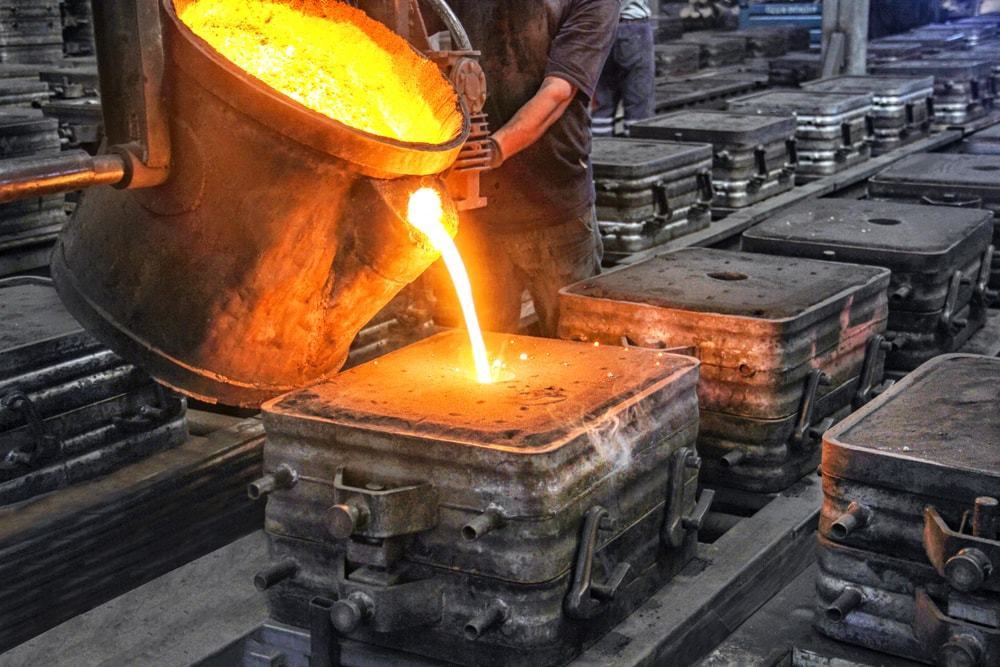
Casting is an assembling procedure by which a fluid material is usually poured into a mould, which includes a vacant cavity of the desired shape, and then authorize to solidify. The solidified part is also known as a casting, which is removed or shivered out of the mould to finish the process
Casting materials are generally metals or numerous cold setting materials that cure after mixing two or more elements together; examples are epoxy, concrete, plaster and clay. Casting is occasionally utilized for creating complex shapes that would be otherwise difficult or extravagant to make by other methods
Following are the basic types of casting:
Sand casting – Sand casting predominantly relies on silica-based materials, such as synthetic or obviously-bonded sand. Casting sand generally contains of finely ground, spherical grains that can be tightly packed all at once into a smooth moulding surface. The casting is designed to lessen the latent for tearing, cracking, or other flaws by authorizing a moderate degree of flexibility and shrinkage during the cooling phase of the process. The sand can also be strengthened with the mixture of clay, which helps the particles bonds more closely. Automotive products like engine blocks are produced by using sand casting.
Die casting – Die casting is a method of moulding materials into high pressure and normally includes non-ferrous metals and alloys, such as zinc, tin, copper, and aluminium. The refillable mould is coated with an emollient to help normalize the die’s temperature and to assist with elements ejection. Molten metal is then injected into the die in high pressure, which leaves continuous until the work piece solidifies. This pressurized insertion is rapid, preventing any segment of the material from hardening before being cast. After the process is finished, the component is taken out of the die and any scrap material is eliminated.
Shell mould casting – Shell moulding, also known as shell-mould casting, is a non-essential mould casting process that utilizes a resin coated sand to form the mould. As compared to sand casting, this process has far better and reliable dimensional accuracy, a higher productivity rate, and lower labor needs. It is utilized for small to medium parts that needs high precision. Shell mould casting is a metal casting process same as to sand casting, in that molten metal is poured into an expendable mould.
Permanent mould casting – Permanent mould casting is metal casting procedure that employs refillable moulds (“permanent moulds”), usually made from metal. The most used process utilizes gravity to fill the mould, however gas pressure or a vacuum are also utilized. An alternative on the particular gravity casting process, known as slush casting produces hollow castings. Mostly used casting metals ale aluminium, magnesium, and copper alloys. Other materials consists of tin, zinc, and lead alloys and iron and steel are also cast in graphite moulds Investment casting (lost wax casting).
There are four main types of permanent mould casting:
- Gravity
- Slush
- Low-pressure
- Vacuum
Lost-foam casting – The ceramic mould, widely known as the investment, is produced by three continual moves: coating, stuccoing, and hardening. The first step consists dipping the cluster into slurry of fine refractory material and then authorizing any surplus drain off, so a uniform surface is generated. This fine material is utilized first to provide a smooth surface finish and recreate fine details. In the second step, the cluster is stuccoed with a coarse ceramic particle, by dipping it into a fluidised bed, putting it in a rainfall-sander, or by applying by hand. Finally, the coating is authorized to harden. These steps are repeated until the investment is the needed thickness, which is generally 5 to 15 mm
Centrifugal casting – Centrifugal casting is utilized to produce long, cylindrical parts like cast iron pipe by relying on the g-forces improving in a spinning mould. Molten metal inaugurating into the mould is flung in position to the interior surface of the mould, producing a casting that can be free of voids. Originally invented as the de Lavaud process using water-cooled moulds, the method is applied to symmetrical parts such as soil pipe and large gun barrels and has the advantage of producing parts using a minimal number of risers. For asymmetric parts that cannot be spun around their own axes, a variant of centrifugal casting, known as pressure casting, arranges several parts around a common sprue and spins the moulds around this axis. An identical idea is registered to the casting of very large gear rings, etc. Relying on the material being cast, metal or sand moulds may be utilized.
Advantages of Castings:
- On basis of size object can be manufactured
- on Basis of Complexity
- Weight Saving
- Control over the Process
- Accuracy
- Fibrous Structure
- Control over Grain Size
- Low Cost
There are many non-identical types of casting processes that are used in production. As you can see, many of them are quite non-identical. Nevertheless, they all bring out a great result depending on what type of product you wish to produce. It’s important that you use the right casting process for your products to make sure they have the cessation and shape that you require.
Using the right casting process make sure that you produce a high-quality product that is made to last.
We at KERONE have a team of experts to help you with your need for Casting Process Machines from our wide experience.
